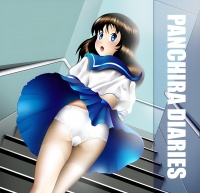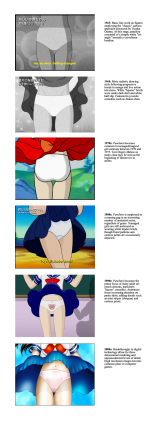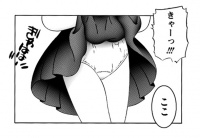Panchira
m (→See also: Add link) |
Midnight68 (Talk | contribs) m (→See also) |
||
| (11 intermediate revisions by 2 users not shown) | |||
| Line 1: | Line 1: | ||
| − | [[ | + | [[File:Kogaru1.jpg|thumb|200px|<center><small>Archetypal panchira image.</small></center>]]'''Panchira''' (パンチラ) means [[voyeurism|upskirt]] in Japan. The word is a portmanteau of "[[panty fetish|panty]]" (パンティー, pantī) and ''chira'', the Japanese sound symbolism representing a glance or glimpse. |
| − | '''Panchira''' (パンチラ) means [[voyeurism|upskirt]] in Japan. The word is a portmanteau of "[[panty fetish|panty]]" (パンティー, pantī) and ''chira'', the Japanese sound symbolism representing a glance or glimpse. | + | |
''Panchira'' is an expression used by Japanese women to warn each other that their underwear is visible; the term carries risqué connotations similar to the phrase "your [[Slip (lingerie)|slip]] is showing" in English usage. | ''Panchira'' is an expression used by Japanese women to warn each other that their underwear is visible; the term carries risqué connotations similar to the phrase "your [[Slip (lingerie)|slip]] is showing" in English usage. | ||
| − | In [[anime]] and [[manga]], ''panchira'' refers to a [[panty shot]] or [[ | + | In [[anime]] and [[manga]], ''panchira'' refers to a [[panty shot]] or [[voyeurism]] (upskirt) take. It has been used extensively by Japanese artists and animators since the early sixties. |
| − | + | ==Origins== | |
| + | [[File:PanchiraTimeline.png|thumb|left|150px|<center><small>Timeline, 1963-2003.</small></center>]]The development of panchira in Japanese popular culture has been analyzed by a number of American and Japanese writers. Many observers link the phenomenon to the Westernization of Japan following [[wikipedia:World War II|World War II]]. During the occupation, fashions, ideas, and media previously unavailable were accessed by the local population, leading to a slight relaxing of earlier taboos. Western-style clothing (including [[Panties|women's underwear]]) gained popularity in the post-war period, reinforced through numerous media outlets—magazines, newspapers, films, journals, and comics. | ||
| − | + | In 1969, the Japanese oil company Maruzen Sekiyū released a television commercial featuring Rosa Ogawa in a mini-skirt that gets blown up by the wind and her lips forming an 'O' in surprise. This led to children imitating her line "Oh! Mōretsu" (Oh!モーレツ, too much, radical), and a fad for sukāto-mekuri (スカート捲り skirt-flipping). Ogawa subsequently appeared in a TV show ''Oh Sore Miyo'' (Oh! それ見よ, literally "look at that," but actually a pun on 'O Sole Mio,' a neapolitan song 'my sunshine') that again featured scenes of her mini-skirt blowing up. | |
| − | + | By the late 1960s, panchira had spread to the mainstream comic industry, as fledgling manga artists such as [[wikipedia:Go Nagai|Go Nagai]] began exploring sexual imagery in boys' comics ([[wikipedia:Shōnen manga|shōnen manga]]). Adult manga magazines had existed since 1956 (e.g. [[wikipedia:Weekly Manga Times|Weekly Manga Times]]), but it is significant to note the introduction of sexual imagery into boys' manga. Millegan argues that the [[wikipedia:Ecchi|ecchi]] genre of the 1970s rose to fill a void left by the decline of [[wikipedia:Osaka|Osaka]]'s lending library network: | |
| + | :<small>Japanese comics did not seriously begin exploring erotic themes until the sixties, with the collapse of the pay-library system (largely brought about by the unexpected success of cheap comic magazines such as Kodansha Publishing's Shōnen Magazine). Artists working for the pay-library system had already pioneered the depiction of graphic violence, and had proudly declared that they were drawing gekiga ("drama pictures"), not mere comics. In the search for realism (and readers), it was inevitable that sex would soon make an appearance. | ||
| + | |||
| + | :As the Japanese comics market diversified, sex spread beyond the gekiga to just about every conceivable niche in the marketplace. The gekiga continued their realistic and often violent depictions, but the other major divisions in the manga world developed their own approach. Boys' comics began to explore "cute" sex, mainly consisting of panchira ("panty shots") and girls in showers. | ||
| + | </small> | ||
| + | |||
| + | ==Anime== | ||
| + | [[File:AkibachanPanchira.jpg|thumb|200px|<center><small>[[wikipedia:Shōnen|Shōnen manga]].</small></center>]]In practice, panchira has been a convention of Japanese cartoons since (at least) the early sixties, when young girls ([[wikipedia:Shōjo manga|shoujo]]) were frequently portrayed with abbreviated hemlines. The convention was almost certainly 'borrowed' from American comics and cartoons, where the archetype had been in place since the 1930s. Japanese animators adopted many of the stylistic elements common to Western 'toongirls', reinterpreting them for early shoujo characters. | ||
| + | |||
| + | One of the best-known examples was Uran from [[wikipedia:Osama Tezuka|Osama Tezuka]]'s [[wikipedia:Astroboy|Testsuwan Atom]] ([[wikipedia:Mushi Production|Mushi]], 1963); like her American predecessors, Uran-chan was designed with an upswept skirt, leaving her plain white briefs on open display. As Uran served as a template for many later female characters, panchira became standard practice within the medium - a defining principle, in fact, still employed to the present day. | ||
| + | |||
| + | Throughout the sixties, panty-shots were comparatively innocent, restricted mainly to school-aged girls (such as [[wikipedia:Mahou Tsukai Sally|Mahou Tsukai Sally]] or [[wikipedia:Akane-chan|Akane-Chan]]) - most probably because depicting a teenaged or adult woman in sexual terms would have been inappropriate at that time. Later characters, such as Mimiko from [[wikipedia:Hayao Miyazaki|Hayao Miyazaki]]'s [[wikipedia:Panda! Go, Panda!|Panda Kopanda!]] employed the panty-shot for light comedy relief; but by and large, panchira was a simple visual convention, devoid of all sexuality. However, the turn of the decade would introduce a number of changes to the basic formula. | ||
| + | |||
| + | ==Magical Girls== | ||
| + | [[File:MihoChan002.jpg|thumb|200px|left|<center><small>1960s [[w:Anime|anime]] character.</small></center>]]During the late sixties, the practice took on overtly voyeuristic overtones with the publication of [[wikipedia:Go Nagai|Go Nagai]]'s [[wikipedia:Harenchi Gakuen|Harenchi Gakuen]]. Set in a high school overrun by perverts and psychopaths, Nagai's controversial manga was the first to depict teenaged girls in unambiguously sexual terms, breaking numerous social taboos and generating major dissent in the Japanese press. Nagai's influence quickly spread to the animation industry with the debut of adolescent heroines such as [[wikipedia:Mahō no Mako-chan|Mahō no Mako-chan]] ([[wikipedia:Toei Animation|Toei Doga]], 1970) or [[wikipedia:Cutie Honey|Cutie Honey]] (Toei 1973, adopted from Nagai's manga of the same name). | ||
| + | |||
| + | It was around this period that animation studios began targeting teenagers and young adults, leading to a prevalence of upskirt takes, panty-shots and gratuitous bathing scenes. Panchira was incorporated into every genre of the artform, from [[wikipedia:Magical girl|mahou shoujo]] fantasies to sci-fi action/adventures (one of the more explicit series of the time - [[wikipedia:Marvelous Melmo|Fushigina Melmo]] - was actually used to teach sex education in Tokyo elementary schools as early as 1971). | ||
| + | |||
| + | As the decade wore on, sexual referencing became increasingly commonplace in anime, eventually leading to the development of [[wikipedia:Ecchi|ecchi]] comedies and mildly risque series such as [[wikipedia:Miss Machiko|Maicching! Machiko-Sensei]] (see below). Strangely, while various degrees of nudity had existed in television animation for several years, panchira still took precedence in the mainstream - due, perhaps, to the long association of panty shots with [[wikipedia:Bishōjo|bishōjo anime]] - cartoons about pretty young girls. | ||
| + | |||
| + | ==Ecchi Comedies== | ||
| + | [[File:TirolchocolateColorA.png|thumb|200px|<center><small>1980s [[wikipedia:Ecchi|ecchi]] humor.</small></center>]]The 1980s saw an expansion and diversification in Japanese animated media, establishing anime as a recognized artform (at least within Japan). Targeting a more adult demographic, various studios began pushing the limits of mainstream [[wikipedia:Fan service|fan service]]. Prime-time television series - including children's cartoons - could now be unambiguously sexual, engaging in farcical humor and patently ribald script-work. The debut of ''Maicching! Machiko-Sensei'' ([[wikipedia:Pierrot (company)|Studio Pierrot]]) in 1981 took fan service to an entirely new level, offering an endless parade of double entendres, gratuitous stripteases and nude shower scenes. | ||
| + | |||
| + | Set in a Tokyo elementary school, ''Maicching! Machiko Sensei'' was - in some respects - a milder version of Nagai's ''Harenchi Gakuen.'' Panchira was a major plot device in the series. Virtually every female character was shown disrobed at one point or another; one of the show's running gags involved the incessant rivalry between the school's male and female students, yielding an unending supply of skirt-flips, 'Marilyn' shots and similar panty-gags. | ||
| + | |||
| + | Phenomenally successful during its three year run, Machiko opened the floodgates on ecchi comedy. Other studios soon followed suite, and ecchi comedy began to appear in even the most unlikely places, such as the popular 'ninja high school' genre ''(Sasuga no Sarutobi)'' or kiddie's fantasies ([[wikipedia:Gu Gu Ganmo|Gugu Ganmo]]). Significantly, this was the same period in which the stereotype Japanese schoolgirl ''(joshikosei)'' began to flourish in anime. Joshikosei were usually depicted with white cotton briefs; a direct reference to the Tezuka years, when shoujo characters invariably wore plain white undergarments (according to other sources, white was also suggestive of innocence and purity). | ||
| + | |||
| + | ==Sukebe Otakus== | ||
| + | [[File:Kogal002a.png|thumb|left|200px|<center><small>Late 90s [[wikipedia:Bishōjo|bishoujo]] game.</small></center>]]Japanese popular culture gained a substantial foothold in the Western market during the 1990s due to numerous factors, including the creation of the WWW and the rapid assimilation of anime into American TV (beginning with Toei's [[wikipedia:Sailor Moon|Sailor Moon]] in 1992). Panchira was one of the many visual imports that arrived in the States via the internet, initially in the form of individual scans and screencaps. Technological improvements (such as [[wikipedia:BitTorrent|BitTorrent]] or [[wikipedia:eMule|eMule]]), allowed users to download entire animated series to their desktops, along with [[wikipedia:Eroge|ero games]], [[wikipedia:Kisakae Set System|KiSS dolls]] and other media unavailable outside of Japan. Similarly, the development of [[wikipedia:Futaba Chan|futaba]] script in Japan had an almost immediate impact in the West, | ||
| + | |||
| + | Multiple imageboard sites like [[wikipedia:2Channel|2channel]] were meticulously copied by American users, resulting in the creation of online communities such as [[wikipedia:4chan|4chan]]. Allowing for anonymous posting and the mass uploading of graphic media, Chan sites attracted an enormous following of anime enthusiasts, gamers, fan artists, trolls and obsessives collectively referred to as [[wikipedia:Otaku|otaku]] (after a Japanese term meaning 'shut-in'). In some cases, entire boards were dedicated to panchira in manga, anime and CG. | ||
| + | |||
| + | Japanese animation studios had been producing adult-oriented anime since the late 80s, and were quick to capitalize on the growing otaku subcultures on both sides of the Pacific. Direct-to-video features were released to the international market; most featured varying degrees of fan service. A number of 'limited' TV series focused specifically on risque humor: [[wikipedia:Najica Blitz Tactics|Najica: Blitz Tactics]] (2001), [[wikipedia:Love Love?|Love Love?]] (2004) and [[wikipedia:Yoiko|Yoiko]] (2004) all featured unprecedented amounts of panchira. One of the earlier entries, [[wikipedia:Agent Aika|Agent Aika: Naked Missions]] (1997), contained one panty shot every 20 seconds. Each catered to an otaku subculture obsessed with animated cliches such as panty-shots or sociopathic violence. | ||
| + | |||
| + | ==Indirect Panchira== | ||
In what can be viewed as a form of self-referential parody, some anime and related productions feature jokes centred around someone's reaction to off-screen panchira. Examples include: | In what can be viewed as a form of self-referential parody, some anime and related productions feature jokes centred around someone's reaction to off-screen panchira. Examples include: | ||
| − | *In the panchira-heavy anime Agent Aika, a man avoids an all-female patrol by hiding under a grate in the floor. After they have walked overhead he emerges with a huge grin and steam coming out of his ears. | + | *In the panchira-heavy anime [[wikipedia:Agent Aika|Agent Aika]], a man avoids an all-female patrol by hiding under a grate in the floor. After they have walked overhead he emerges with a huge grin and steam coming out of his ears. |
*Blue Seed | *Blue Seed | ||
*Colorful | *Colorful | ||
| Line 27: | Line 61: | ||
==See also== | ==See also== | ||
| + | *[[Anime]] | ||
| + | *[[Exhibitionism]] | ||
| + | *[[Hentai]] | ||
| + | *[[Manga]] | ||
| + | *[[Panties]] | ||
*[[Skirt up]] | *[[Skirt up]] | ||
| + | *[[Upskirt]] | ||
*[[Voyeurism]] | *[[Voyeurism]] | ||
| Line 33: | Line 73: | ||
{{SM201|Panchira}} | {{SM201|Panchira}} | ||
[[Category:AltSex]] | [[Category:AltSex]] | ||
| + | [[Category:Anime]] | ||
| + | [[Category:Art]] | ||
| + | [[Category:Exhibitionism]] | ||
| + | [[Category:Manga]] | ||
| + | [[Category:Media]] | ||
| + | [[Category:Panchira]] | ||
| + | [[Category:Panties]] | ||
| + | [[Category:Voyeurism]] | ||
Latest revision as of 05:51, 20 November 2023
Panchira (パンチラ) means upskirt in Japan. The word is a portmanteau of "panty" (パンティー, pantī) and chira, the Japanese sound symbolism representing a glance or glimpse.Panchira is an expression used by Japanese women to warn each other that their underwear is visible; the term carries risqué connotations similar to the phrase "your slip is showing" in English usage.
In anime and manga, panchira refers to a panty shot or voyeurism (upskirt) take. It has been used extensively by Japanese artists and animators since the early sixties.
Contents |
[edit] Origins
The development of panchira in Japanese popular culture has been analyzed by a number of American and Japanese writers. Many observers link the phenomenon to the Westernization of Japan following World War II. During the occupation, fashions, ideas, and media previously unavailable were accessed by the local population, leading to a slight relaxing of earlier taboos. Western-style clothing (including women's underwear) gained popularity in the post-war period, reinforced through numerous media outlets—magazines, newspapers, films, journals, and comics.In 1969, the Japanese oil company Maruzen Sekiyū released a television commercial featuring Rosa Ogawa in a mini-skirt that gets blown up by the wind and her lips forming an 'O' in surprise. This led to children imitating her line "Oh! Mōretsu" (Oh!モーレツ, too much, radical), and a fad for sukāto-mekuri (スカート捲り skirt-flipping). Ogawa subsequently appeared in a TV show Oh Sore Miyo (Oh! それ見よ, literally "look at that," but actually a pun on 'O Sole Mio,' a neapolitan song 'my sunshine') that again featured scenes of her mini-skirt blowing up.
By the late 1960s, panchira had spread to the mainstream comic industry, as fledgling manga artists such as Go Nagai began exploring sexual imagery in boys' comics (shōnen manga). Adult manga magazines had existed since 1956 (e.g. Weekly Manga Times), but it is significant to note the introduction of sexual imagery into boys' manga. Millegan argues that the ecchi genre of the 1970s rose to fill a void left by the decline of Osaka's lending library network:
- Japanese comics did not seriously begin exploring erotic themes until the sixties, with the collapse of the pay-library system (largely brought about by the unexpected success of cheap comic magazines such as Kodansha Publishing's Shōnen Magazine). Artists working for the pay-library system had already pioneered the depiction of graphic violence, and had proudly declared that they were drawing gekiga ("drama pictures"), not mere comics. In the search for realism (and readers), it was inevitable that sex would soon make an appearance.
- As the Japanese comics market diversified, sex spread beyond the gekiga to just about every conceivable niche in the marketplace. The gekiga continued their realistic and often violent depictions, but the other major divisions in the manga world developed their own approach. Boys' comics began to explore "cute" sex, mainly consisting of panchira ("panty shots") and girls in showers.
[edit] Anime
In practice, panchira has been a convention of Japanese cartoons since (at least) the early sixties, when young girls (shoujo) were frequently portrayed with abbreviated hemlines. The convention was almost certainly 'borrowed' from American comics and cartoons, where the archetype had been in place since the 1930s. Japanese animators adopted many of the stylistic elements common to Western 'toongirls', reinterpreting them for early shoujo characters.One of the best-known examples was Uran from Osama Tezuka's Testsuwan Atom (Mushi, 1963); like her American predecessors, Uran-chan was designed with an upswept skirt, leaving her plain white briefs on open display. As Uran served as a template for many later female characters, panchira became standard practice within the medium - a defining principle, in fact, still employed to the present day.
Throughout the sixties, panty-shots were comparatively innocent, restricted mainly to school-aged girls (such as Mahou Tsukai Sally or Akane-Chan) - most probably because depicting a teenaged or adult woman in sexual terms would have been inappropriate at that time. Later characters, such as Mimiko from Hayao Miyazaki's Panda Kopanda! employed the panty-shot for light comedy relief; but by and large, panchira was a simple visual convention, devoid of all sexuality. However, the turn of the decade would introduce a number of changes to the basic formula.
[edit] Magical Girls
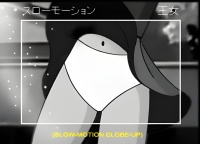
It was around this period that animation studios began targeting teenagers and young adults, leading to a prevalence of upskirt takes, panty-shots and gratuitous bathing scenes. Panchira was incorporated into every genre of the artform, from mahou shoujo fantasies to sci-fi action/adventures (one of the more explicit series of the time - Fushigina Melmo - was actually used to teach sex education in Tokyo elementary schools as early as 1971).
As the decade wore on, sexual referencing became increasingly commonplace in anime, eventually leading to the development of ecchi comedies and mildly risque series such as Maicching! Machiko-Sensei (see below). Strangely, while various degrees of nudity had existed in television animation for several years, panchira still took precedence in the mainstream - due, perhaps, to the long association of panty shots with bishōjo anime - cartoons about pretty young girls.
[edit] Ecchi Comedies
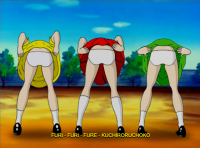
Set in a Tokyo elementary school, Maicching! Machiko Sensei was - in some respects - a milder version of Nagai's Harenchi Gakuen. Panchira was a major plot device in the series. Virtually every female character was shown disrobed at one point or another; one of the show's running gags involved the incessant rivalry between the school's male and female students, yielding an unending supply of skirt-flips, 'Marilyn' shots and similar panty-gags.
Phenomenally successful during its three year run, Machiko opened the floodgates on ecchi comedy. Other studios soon followed suite, and ecchi comedy began to appear in even the most unlikely places, such as the popular 'ninja high school' genre (Sasuga no Sarutobi) or kiddie's fantasies (Gugu Ganmo). Significantly, this was the same period in which the stereotype Japanese schoolgirl (joshikosei) began to flourish in anime. Joshikosei were usually depicted with white cotton briefs; a direct reference to the Tezuka years, when shoujo characters invariably wore plain white undergarments (according to other sources, white was also suggestive of innocence and purity).
[edit] Sukebe Otakus
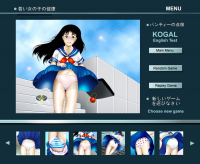
Multiple imageboard sites like 2channel were meticulously copied by American users, resulting in the creation of online communities such as 4chan. Allowing for anonymous posting and the mass uploading of graphic media, Chan sites attracted an enormous following of anime enthusiasts, gamers, fan artists, trolls and obsessives collectively referred to as otaku (after a Japanese term meaning 'shut-in'). In some cases, entire boards were dedicated to panchira in manga, anime and CG.
Japanese animation studios had been producing adult-oriented anime since the late 80s, and were quick to capitalize on the growing otaku subcultures on both sides of the Pacific. Direct-to-video features were released to the international market; most featured varying degrees of fan service. A number of 'limited' TV series focused specifically on risque humor: Najica: Blitz Tactics (2001), Love Love? (2004) and Yoiko (2004) all featured unprecedented amounts of panchira. One of the earlier entries, Agent Aika: Naked Missions (1997), contained one panty shot every 20 seconds. Each catered to an otaku subculture obsessed with animated cliches such as panty-shots or sociopathic violence.
[edit] Indirect Panchira
In what can be viewed as a form of self-referential parody, some anime and related productions feature jokes centred around someone's reaction to off-screen panchira. Examples include:
- In the panchira-heavy anime Agent Aika, a man avoids an all-female patrol by hiding under a grate in the floor. After they have walked overhead he emerges with a huge grin and steam coming out of his ears.
- Blue Seed
- Colorful
- Iketeru Futari
- Najica Blitz Tactics
- Air Master
- Ikki Tousen
- Kirameki Project
- AIKa R-16: Virgin Mission
- In an episode of the anime Trigun, a female hostage shoots her captor with a weapon held between her feet, since her hands are tied. The captor's last words are "They were white."
- In the OEL-manga (Original English-language-manga) webcomic Megatokyo, a miniskirted schoolgirl is crouching beside an injured man who complains of seeing spots. She hits him before realising he didn't mean her underwear because she's wearing stripes.
[edit] See also
| This page uses content from SM-201; the original article can be viewed here. |
